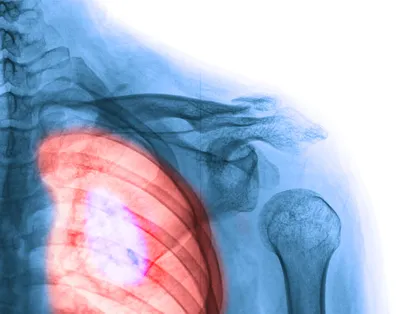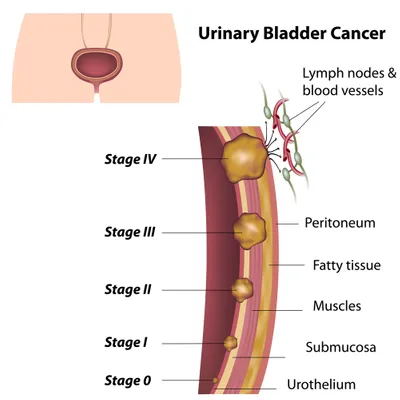Nearly all types of cancers can develop into “metastatic tumors,” which refers to cancer cells that spread to other tissues throughout the body.
Metastasis occurs when cancer cells invade nearby healthy tissues through these six methods:
- Circulation—via the lymphatic system and the bloodstream to other body parts.
- Angiogenesis—in which cancer cells reproduce into micrometastases (small tumors) to stimulate the development of fresh blood vessels and latch onto the blood supply.
- Proliferation—where cancer cells reproduce and form micrometastases in remote tissues.
- Local invasion—cancer cells penetrate neighboring healthy tissues.
- Arrest and extravasation—cancer cells lodge in the capillary walls and penetrate surrounding tissues.
- Intravasation—cancer cells penetrate the walls of nearby lymph vessels or blood vessels.
Although most cancers have the ability to spread to virtually any part of the body, these are the most common types of metastasized cancer…
1. Metastatic Breast Cancer
Main sites of metastasis: Bone, lung, brain, and liver.
According to the National Breast Cancer Foundation, the symptoms of metastatic breast cancer vary as far as type and severity depending on the site of metastasis (spreading). However, warning signs include swelling, progressive pain, vision issues, nausea, seizures, mood changes, frequent bone fractures, continual migraines, skin rash and irritation, appetite loss, weight loss, chronic fatigue, and even jaundice.
2. Metastatic Colorectal Cancer
Main site of metastasis: Peritoneum, liver, and lung.
Considered one of the most prevalent cancers in the U.S. by the John Hopkins School of Medicine, metastatic colorectal cancer develops when cancer cells from the colon or rectum spread to other areas of the body—namely the liver, lung, and peritoneum. During the early stage, colorectal cancer may display no signs at all. However, as the disease worsens, symptoms of bone pain, multiple fractures and fatigue may occur due to high calcium levels as cancer invades the bones. If cancer metastasizes in the lungs breathing issues, wheezing, chest pain, and shortness of breath may be prominent. Colorectal cancer in the stomach lymph nodes will cause a distended stomach, cramps, and loss of appetite. Nausea, jaundice, and swelling of the stomach, hands and feet are common if cancer lands in the liver. While metastasis in the spinal cord or brain can cause blurred vision, seizures, slurred speech, headache, memory loss, and mobility issues.
3. Metastatic Lung Cancer
Main site of metastasis: Adrenal gland, bone, brain, and liver.
Metastatic tumors in the lungs spread from their place of origin via the bloodstream. The National Institutes of Health consider metastatic lung cancer as one of the most difficult to diagnose due it’s vague combination of symptoms—including chest pain, chronic and/or bloody cough, fatigue, sudden weight loss, and shortness of breath—which can easily be mistaken for another health issue.
4. Metastatic Bladder Cancer
Main site of metastasis: Lung, bone, and liver.
Doctors consider the symptoms of metastatic bladder cancer “non-specific,” meaning they are often associated with numerous other health conditions and can be mistaken for disorder other than cancer. According to a 2010 study conducted by Cancer Research UK, there’s a prevalence of bladder cancer in older males (between the age of 50 and 80) who smoke. Sudden changes in urinary behavior—including pain or burning when urinating (with a clean urinary tract infection test), frequent urination, pressure on the bladder, and blood in the urine (a condition known as hematuria)—are also signs that bladder cancer has metastasized.
5. Metastatic Kidney Cancer
Main site of metastasis: Bone, lung, adrenal gland, brain, and liver.
Metastatic renal cell cancer occurs when cancer cells spread beyond the area of origin (the kidney), typically invading the fatty tissues and blood vessels or fatty tissue around the kidneys. From there, cancer can further metastasize to the lymph nodes, traveling to the brain, lungs, and bones. Symptoms are unfortunately inconspicuous in the early phases and include loss of appetite, sudden weight loss, blood-tinged urine, abdominal pain, anemia, unexplained fever, bloody cough, bone pain, and swelling of the extremities, which can be easily blamed on other health issues. According to Kidney Cancer Canada this means that approximately 25% of kidney cancer patients are diagnosed from the outset with metastatic (or stage IV) cancer.
6. Metastatic Uterine Cancer
Main site of metastasis: Bone, liver, lung, peritoneum, and vagina.
The American Cancer Society reported 52,630 new cases of uterine cancer and 8,590 U.S. deaths due to endometrial cancer and uterine sarcomas in 2014. The majority of uterine cancers originate in the endometrium (the lining of uterus) resulting in telltale symptoms—such as pelvic pain, sudden weight loss, irregular spotting (either between periods or during menopause), and discolored/bloody vaginal discharge.
7. Metastatic Prostate Cancer
Main site of metastasis: Adrenal gland, bone, liver, and lung.
Prostate cancer results when the prostate gland (the walnut sized located under the male bladder) produce an excess of abnormal cells that in turn spread (or metastasize) throughout the body killing healthy tissues. Oftentimes, there are no symptoms in the early stages of prostate cancer. Once advanced, symptoms can include weak or abnormal urine stream; pain or burning during urination; blood-tinged urine; sudden weight loss; frequent urination (especially during the night); pain in the back, hips, and upper thighs; and swelling of the feet, legs, and ankles. Luckily, a simple prostate-specific antigen (PSA) blood test can determine prostate cancer.
8. Metastatic Stomach Cancer
Main site of metastasis: Liver, lung, and peritoneum.
Akin to many other forms of cancer, the symptoms of stomach cancer can often be nondescript in the early stages. However, as the cancer advances, patients often report nausea, bloody vomit, sudden weight loss, chronic stomach pain, abdominal swelling, swallowing issues, a full feeling even following a small meal, and blood-tinged stool. These symptoms will often be misdiagnosed as a stomach ulcer. Doctors will typically use an Endoscopy, a procedure that involves the insertion of a thin, lighted tube into the stomach, to explore the area for tumors.
9. Metastatic Thyroid Cancer
Main site of metastasis: Bone, liver, and lung.
According to the American Cancer Society, there were roughly 63,000 new cases of thyroid cancer reported in 2014 across the U.S. Thyroid cancer, unlike many others, tends to strike at a much younger age. In fact, 2 out of 3 cases are diagnosed in men and women under the age of 55-years-old. Thyroid cancer originates in the thyroid gland, a butterfly-shaped gland located in the front portion of the neck (below the Adam’s apple in men). Cancerous, or malignant, thyroid tumors can spread into nearby tissues as well as to other parts of the body via the lymph nodes in the neck. Common signs that thyroid cancer has metastasized include enlarged lymph nodes, neck pain or visible lumps, voice hoarseness (if a tumor is pressing on the voice box), difficulty swallowing, chronic cough, and even coughing up blood if the cancer has metastasized in the lungs.












